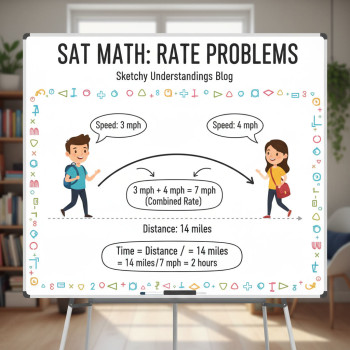Why data interpretation matters more than you think
When you open a Digital SAT Reading or Math section, you’re not always greeted by equation-heavy problems or long narrative passages. Increasingly, the test presents data — charts, tables, scatterplots, timelines, and short excerpts with embedded statistics — and asks you to draw a conclusion. Those moments separate students who rely on instincts from students who rely on reasoning. The good news? Data interpretation is a learnable skill, and improving it often yields quick score gains.
What is data interpretation on the Digital SAT?
Data interpretation is the practice of extracting meaningful information from a graphical or numerical representation and using that information to answer questions. On the Digital SAT you’ll see:
- Tables that present raw numbers (e.g., test scores by group).
- Bar graphs that compare categories (e.g., population by region).
- Line graphs that track change over time (e.g., revenue across years).
- Scatterplots showing relationships between two variables.
- Combined displays — a small table next to a passage, or a graph embedded inside a reading passage.
Each format nudges you to think differently. A table rewards precision and basic arithmetic; a scatterplot rewards understanding of trends and outliers; a passage with embedded data tests your ability to integrate textual claims with numbers.
How data interpretation shows up differently in Reading vs. Math
It’s tempting to lump all ‘data questions’ together, but the Digital SAT treats them somewhat differently depending on the section.
Reading & Writing: numbers tell a story
In Reading, data often appears as support for or against an author’s claim. A short passage might make a claim about literacy rates, and a table or chart provides evidence you must weigh. The challenge here is twofold: one, understand what the data literally says; and two, connect that fact to the author’s argument. Misreading the axis labels or mistaking a percentage for a raw count will lead to tempting but wrong answer choices that sound plausible.
Math: precision, operations, and interpretation
In Math, data interpretation tests your arithmetic fluency and your ability to model scenarios. You might be asked to compute a rate, compare ratios, or determine which statement accurately follows from the graph. The math isn’t always advanced — often it’s proportional reasoning, percent changes, averages, or slope — but the stopwatch is ticking and the pressure grows when the data is dense.
Common traps and how to avoid them
Knowing where test-writers like to hide traps saves time and prevents careless errors. Here are the most common pitfalls students face with data interpretation on the SAT.
1. Misreading axes and labels
Graphs sometimes compress categories or use unfamiliar units. Before calculating, always ask: what does each axis measure? Does the y-axis start at zero? Are the units millions, percentages, or raw counts? A small oversight here can flip your answer.
2. Confusing totals with averages
Tables often present totals and subgroup counts side-by-side. A question might ask which group has the highest average — requiring you to divide totals by counts — and a quick scan can trick you into choosing the largest total instead of the largest average.
3. Ignoring context in Reading passages
A data point that contradicts a passage’s claim may still support the author if the author conditions the claim (e.g., “most cities in Region A saw increases” vs. “City X saw a decrease”). Always compare the passage language to the scope of the data.
4. Overreacting to outliers
A dramatic spike in a graph is attention-grabbing but may be a single outlier. Depending on the question, you may need to focus on central tendency rather than the spike. Ask whether the outlier changes the overall conclusion.
Step-by-step approach to solve data questions fast
If you memorize a reliable sequence of actions, the test becomes less scary. Here’s a practical approach you can use on both Reading and Math sections.
- Scan the question first: Know what you’re looking for before you dive into the data. Is the question asking for a calculation, an inference, or a direct read?
- Read labels and units: Double-check axes, legend entries, and whether numbers are percentages, absolute values, or indexed values.
- Estimate quickly: Can you rule out answers by rough estimation? For multiple-choice questions, eliminating two wrong answers halves your work.
- Compute carefully: Do the arithmetic when needed. Use scratch work to avoid mental slip-ups.
- Double-check contextual fit: For Reading questions, ensure your numeric answer aligns with the passage’s scope and wording.
- Watch for answer-choice traps: Test writers often include answers that are numerically close to the correct one but wrong because of a unit mistake or misread axis.
Real example (walk-through)
Let’s walk through a compact example that combines a table and a short Reading prompt. Practice like this helps build intuition.
Scenario
A short passage claims: “Between 2015 and 2020, City A invested more heavily in public transit than City B, which explains the faster drop in average commute times in City A.” A table shows average commute times (in minutes) for the two cities across years: 2015 (City A: 32, City B: 35), 2016 (30, 34), 2017 (29, 32), 2018 (27, 31), 2019 (26, 30), 2020 (25, 29).
Question
Which statement is best supported by the data?
- A. City A’s average commute time fell faster because of higher investment in public transit.
- B. City A’s average commute time decreased by 7 minutes, while City B’s decreased by 6 minutes.
- C. Both cities had equal year-to-year decreases.
- D. City B’s commute time was always lower than City A’s.
Walk-through
Start by checking what the data literally shows: City A goes from 32 to 25 (a drop of 7 minutes); City B goes from 35 to 29 (a drop of 6 minutes). That directly supports choice B. Choice A introduces causation (investment in transit) that the table does not prove — it’s plausible but not demonstrated. Choice C is false because year-to-year decreases vary by year. Choice D is false because City A is lower in most years after 2016, or at least the two converge. So B is the best-supported answer.
This example highlights two important lessons: (1) look for what the data actually shows before accepting narrative claims, and (2) be cautious about cause-and-effect language in passages.
Mini-guide to the most useful math skills for data interpretation
You don’t need advanced calculus for the SAT — you need fluency with basic numeric reasoning. Here’s a checklist of the most useful skills and a quick practice routine.
Key skills
- Percentages and percent change (increase/decrease)
- Ratios and proportions
- Averages (mean) and weighted averages
- Rates (e.g., speed = distance/time, or per-1000 rates)
- Slope and trend recognition in line graphs
- Reading and interpolating values from tables and axes
Practice routine (10 minutes a day)
- Day 1–3: Do 10 percent change problems; time yourself.
- Day 4–6: Work on ratios and proportions from real-world tables (e.g., recipes, budgets).
- Day 7: Mixed set — five quick problems with a graph and five with a table.
| Skill | Why it helps | Practice tip |
|---|---|---|
| Percent change | Many questions ask how much something increased or decreased | Convert to decimals; remember formula: (new-old)/old |
| Ratios | Useful for comparing groups or populations | Set up proportion x/y = a/b and cross-multiply |
| Averages | Helps interpret totals vs. per-person numbers | Practice weighted averages with classroom examples |
| Slope/trend | Quickly identifies direction and rate of change | Estimate slope by rise/run between two clear points |
Reading strategies when data and prose meet
When numbers live inside a passage, your task is to hold two conversations at once: what the author is claiming and what the data actually demonstrates. Here’s how to juggle both without dropping the ball.
Annotate selectively
Highlight or underline the author’s main claim and any qualifiers (words like “mostly,” “typically,” or “especially”). Then scan the figure and write a one-line summary on your scratch paper — for example, “Table: City A fell 7 min, City B fell 6 min.” That short note helps you compare claims to evidence quickly.
Watch for scope mismatch
Authors may make broad claims (“students in the country improved”) while the data is narrow (“sample of 200 students in one district”). If the scope doesn’t match, the author’s conclusion is weaker. On the SAT, the best-supported answer will respect scope.
Be literal first, interpret second
First, answer the question that relies purely on the numbers. Then, if a question asks about interpretation, layer in the author’s language. This two-step prevents you from letting persuasive prose override clear data.
Time management tips for data-heavy sections
Data questions can be deceptively time-consuming. Here are tactics to keep your pacing steady without sacrificing accuracy.
- Answer the question that looks quickest first. If a table has five questions and one is a simple read-off, start there.
- Use estimation to eliminate choices. If the answers are clustered around 10–12 and one option is 25, you can usually rule out the outlier fast.
- When stuck, mark and return. It’s better to answer easier items first and reserve time for careful work on more complex data tasks.
- Practice digital navigation. On the Digital SAT, toggling between passage and graph is fast — simulate that in practice so you’re efficient on test day.
How to build data literacy outside the SAT
The skills you develop for SAT data interpretation are valuable beyond the test. Here are simple, everyday ways to level up.
- Read the short data stories in newspapers or news apps. Try to summarize the chart in one sentence.
- When you see an infographic, ask: what is the source, what are the units, and could this be misleading?
- Create small projects: chart your weekly screen time or sleep and write three sentences about the trend.
How tailored tutoring accelerates mastery (where Sparkl fits in)
Everyone learns at a different pace. For some students, a single concept — like correctly handling percent change — unlocks multiple question types. That’s where personalized tutoring shines. Sparkl’s personalized tutoring offers 1-on-1 guidance and tailored study plans that zero in on weak points: if your trouble is reading axis labels, tutors can create targeted drills; if your timing is off, they can simulate timed practice with feedback. Sparkl also combines expert tutors with AI-driven insights to track progress and suggest the next high-impact skills to practice.
Think of tutoring not as spoon-feeding answers but as sharpening your approach. An experienced tutor will challenge sloppy habits, teach you useful shortcuts, and help you convert mistakes into lasting improvements.
Sample study week: data interpretation focus
This plan assumes about 6–8 hours of study across a week — a manageable block for most students preparing while in school.
Monday — Foundations (1 hour)
- Review percent change and ratios. Do 12 problems, timed.
- Review one short reading passage with an embedded table.
Tuesday — Graph fluency (1.5 hours)
- Practice interpreting bar, line, and scatterplots. Sketch quick notes for each graph.
- Work on slope estimation and identifying outliers.
Wednesday — Combined skills (1 hour)
- Mixed set of reading and math data questions. Focus on eliminating wrong choices fast.
Thursday — Timed set (1.5 hours)
- Simulate a test block: 20–25 items with at least 5 data-heavy questions. Practice navigation and pacing.
Friday — Error review and strategy (1 hour)
- Carefully review mistakes. Identify whether errors came from reading, arithmetic, or assumptions.
Weekend — Big practice and reflection (1.5–2 hours)
- Do a full practice section or a mixed set. Afterward, write a short reflection: what types of data cost you time? What will you practice next week?
One more real-world comparison to cement intuition
Imagine two restaurants. Restaurant X reports it served 2,000 customers in a month with a total revenue of $60,000. Restaurant Y served 1,000 customers with revenue $40,000. Which is more profitable per customer? The raw totals suggest X is bigger, but per-customer revenue is $30 for X and $40 for Y, so Y is more lucrative per customer. This everyday ratio reasoning mirrors many SAT questions: totals are interesting, but per-unit comparisons often matter more.
Final checklist before test day
- Practice reading axis labels carefully and always identify units.
- Memorize and rehearse percent change and ratio formulas until they’re second nature.
- Use scratch paper to jot one-line summaries of tables or graphs before answering Reading questions.
- Practice timed sets to build digital navigation speed and comfort.
- If you feel stuck on how to structure practice, consider short, focused tutoring sessions. Personalized plans — like those Sparkl provides — can create a high-return practice schedule that targets exactly where you lose points.
Parting thought: data interpretation as a power skill
Mastering data interpretation changes how you approach the Digital SAT. It makes you less likely to be fooled by attractive but incorrect answer choices and more likely to find clean, provable solutions under time pressure. Beyond the test, this skill helps you read news more skeptically, make better decisions with numbers, and communicate ideas clearly when numbers matter.
Prep is a series of small, deliberate choices: choosing the right problems to practice, reflecting on errors, and seeking targeted help when necessary. Whether you follow the weekly plan above, build your own, or work with a tutor, focus on the mechanics (labels, units, arithmetic) and the habits (annotating, estimating, checking). Those habits convert data into insight — and insight into confidence on test day.
Ready to get started?
Pick one data format (table, bar graph, line graph, scatterplot) and practice it for 10 minutes today. Small, steady improvements add up. If personalized guidance would help you stay focused and efficient, consider scheduling a short diagnostic session with a tutor who can build a tailored plan — targeted practice often beats more hours of unguided study. You’ll be surprised how quickly clarity follows when you practice with purpose.
Good luck — interpret clearly, calculate carefully, and let the numbers help you tell the right story on test day.














No Comments
Leave a comment Cancel